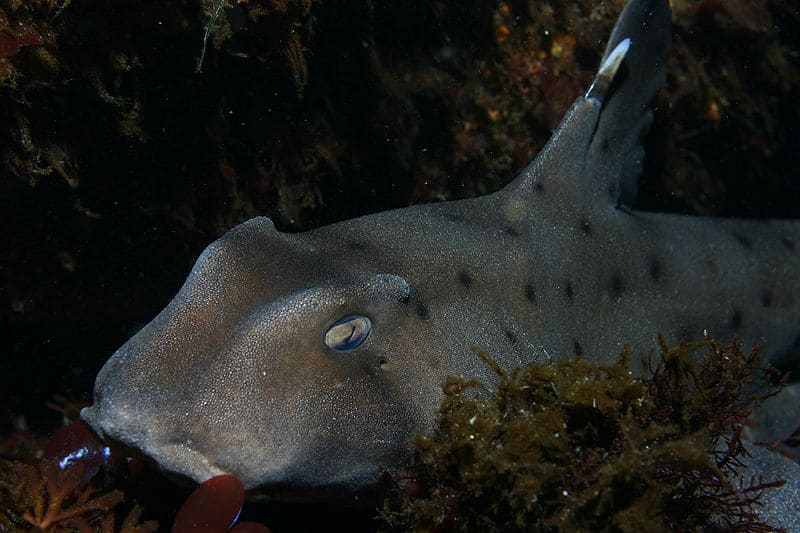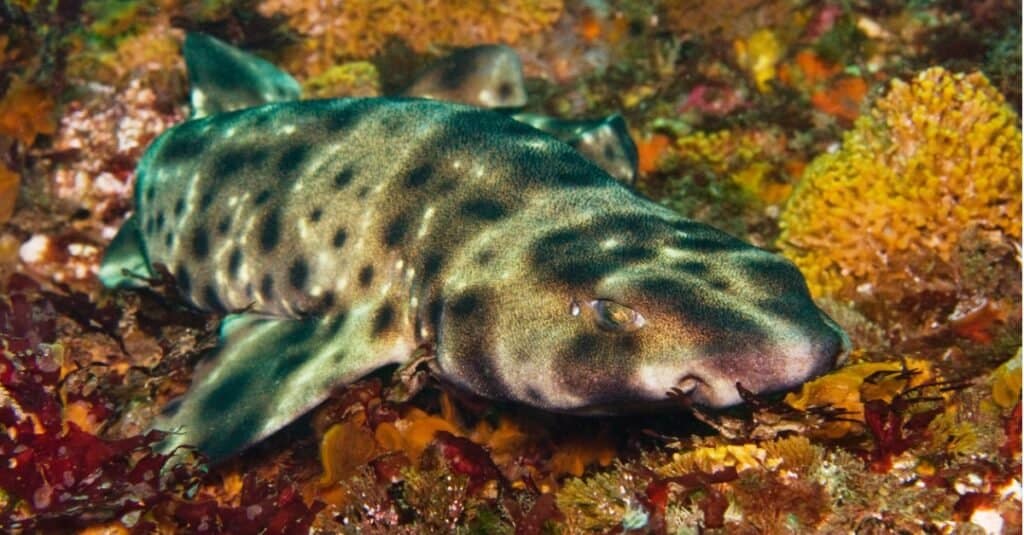When we think of sharks we typically picture a large torpedo-shaped body and hundreds of razor-sharp teeth. You know, something like a bull shark or the notorious great white shark. However, there are actually more than 500 different species of sharks that come in all different shapes and sizes!
Some of nature’s most bizarre-looking sharks display rather curious adaptations—things like glowing skin and chainsaw snouts. Let’s take a closer look at 10 of the most unusual looking sharks!
1. Horn Shark

Horn sharks have unusually large protrusions over their eyes, making them look like some type of prehistoric dinosaur.
©Chad King – Public Domain
Unlike many other shark species, horn sharks prefer spending their time in the same general area. These sharks usually live in more shallow waters and often don’t venture further than 40 feet deep. However, horn sharks are not very graceful creatures. In fact, they’re slow swimmers and rather clumsy. Often these sharks just use their fins to crawl along the sea bottom instead of swimming. Despite their awkward swimming skills, horn sharks can protect themselves against predators with sharp spines in front of their fins.
Horn sharks spend their days hidden in rock crevices and come out at night to hunt. They have an unusual combination of both sharp teeth as well as tough teeth they use to crush crabs and sea urchins. Sea urchins are by far their favorite meal, and if a horn shark eats too many of them, it stains their teeth purple!
2. Ninja Lanternshark
When researcher Vicky Vásquez told her young cousins about a newly discovered shark, the 8-year-olds told her it looked like a super ninja shark. Inspired by the children’s description, the team announced that the name of their new discovery would be the “ninja lanternshark”.
Ninja lanternsharks are small, growing only 1.5 feet long at most. These unusual sharks have large bulbous eyes and very small, slender heads and bodies. Their skin is jet-black but contains photophores that allow them to glow in the dark.
3. Thresher Shark

The most notable feature of the thresher shark is the long, whip-like upper lobe of their tail, which is known as the caudal fin.
©Shane Gross/Shutterstock.com
The thresher shark does not look too strange at first glance—until you notice its unusually long tail. The top of its tail fin is as long as the shark’s entire body! At first, scientists were not sure what the tail’s purpose was, but in 2010 Pelagic threshers were observed using their tails as whips!
Thresher sharks use their long tail fins to literally whip schools of fish. Not only do the sharks stun and kill the fish, but their tails are strong enough to dismember their prey. A thresher shark’s powerful tail whip has been clocked at up to 80 mph per hour!
4. Pocket Shark
If you look at a pocket shark, you might question whether or not it is even a shark at all. That is because this unusual little shark looks much more like a miniature sperm whale than a shark. Pocket sharks were only discovered in 2010 and scientists do not know much about them, but they sure do have an unusual appearance to say the least. These sharks are extremely small, between only 5-6 inches in length. Interestingly, however, their name does not come from their small size, but from a pocket-sized orifice found near each of their pectoral fins.
5. Swell Shark

Swell sharks can double in size by swallowing water
©iStock.com/Natalie Ruffing
Like their name, swell sharks can literally “swell” to twice their normal size! These unusual-looking sharks can suck in and swallow large amounts of seawater, making their bodies swell in size. This is a helpful tool at night when they are hunting. It helps the sharks look much bigger and more intimidating, keeping potential predators away.
During the day swell sharks sleep in rocky crevices, and often use their unique swelling ability to wedge their bodies into the rocks so that predators cannot pull them out. Swell sharks are typically around 35-40 inches long with spotted yellowish-brown bodies. Their heads are flattened with a rounded snout, and large golden cat-like eyes.
6. Velvet Belly Lanternshark
One of the most common sharks living in the deep waters of the Atlantic and Mediterranean Oceans is the velvet belly lanternshark. These sharks are a small species of dogfish shark, growing only 18 inches long at most. Their small size makes velvet belly lanternsharks vulnerable to much larger predators. However, these small sharks have their own secret weapons: glow-in-the-dark spines!
Velvet belly laternsharks have transparent spines that light up with the bioluminescent cells along the shark’s dorsal fins. Their glowing spines act as a message to potential predators, warning them that a velvet belly laternshark is a tough meal to swallow. These unusual looking sharks also have a velvety black belly with light-emitting photophores that create a unique bioluminescent pattern.
7. Angular Roughshark or Pig-Faced Shark
Technically the name of this shark is the angular roughshark. However, due to the shark’s unusually shaped snout, many people simply refer to it as the pig-faced shark. Pig-faced sharks have flattened, upturned snouts, giving them faces a snub-nose or piglike appearance. In addition, these sharks even make pig-like grunting noises when they are pulled from the water! Pig-faced sharks only grow around 3 feet in length, but their bodies are large and thick, with two very large dorsal fins that look like giant sails. Unfortunately, their large fins cause pig-faced sharks to get accidentally caught in fishing nets. Because of this, they are considered a vulnerable species.
8. Saw Shark

Saw sharks have additional nasal barbells midway down their long snouts that help them in locating prey.
©Chaos2Light Images/Shutterstock.com
As their name suggests, the Saw Shark has a long “saw” for a nose! The shark’s rostrum, or snout, is elongated and flat, with teeth-like scales that make it look like some sort of chainsaw. In addition, there are sharp teeth that protrude from the edges of the shark’s saw-like snout. Saw sharks use their saw-like snouts to slash side to side, helping them to basically slice and dice their prey before eating them.
However, the sharks’ unusual snouts are more than just a dangerous weapon or kitchen tool. Saw sharks also use their long saw-shaped snouts to locate food! There are electroreceptors underneath these long snouts, called Ampullae of Lorenzini. Saw sharks are bottom dwellers and use the electroreceptors under their snouts to locate and attack prey animals buried in the sand.
9. Catshark

We are not entirely sure why cat sharks glow, but a prevalent theory is that it helps the sharks to recognize each other. It also may help them to find a mate, since male and female catsharks emit different glowing patterns
©iStock.com/atese
Catsharks have an unusually colorful appearance, with lots of spots or jaguar-like patterns painted all across their skin. In addition, they also have cat-shaped eyes that are very sensitive to light. The sharks’ eyes contain long rods that are attuned to green and blue light, which helps them see better in dim lighting. This comes in handy since catsharks live in the dark deep waters of the ocean, often between 1,640-1,970 feet below the surface.
In 2016, scientists discovered another characteristic that only added to this shark’s unusual appearance. It turns out that catsharks are biofluorescent and glow in the dark! This is different than the much more common bioluminescence, which is when organisms use a chemical reaction to produce their own light. The biofluorescence of a cat shark, on the other hand, deals with a special pigment in the shark’s skin that absorbs blue light. The only color that can penetrate that far down into the ocean is blue, so the catshark’s biofluorescent skin absorbs it, and transforms it into a glowing green light.
10. Angel Shark

Angel Sharks suck in their prey like a vacuum.
©LuisMiguelEstevez/Shutterstock.com
Although it may not look like the most “angelic” creature in the ocean, the Angel Shark certainly has its own unusual appearance. Angel sharks look more like a ray than a shark because of their flat bodies and very long pectoral and pelvic fins. They also have blunted snouts and large mouths filled with sharp teeth. Juvenile angel sharks have an even more unusual appearance than the adults. These young sharks have an extra set of fake eyes! Their fake eyes, or ocellus, help to protect young sharks by confusing potential predators.
Angel sharks are nocturnal and spend most of the day buried along the seabed and in ocean rocks. At night they hide in the sand as they wait for lobsters, fish, krill, and squids to swim close enough to ambush.
The photo featured at the top of this post is © iStock.com/dottedhippo
Thank you for reading! Have some feedback for us? Contact the AZ Animals editorial team.






